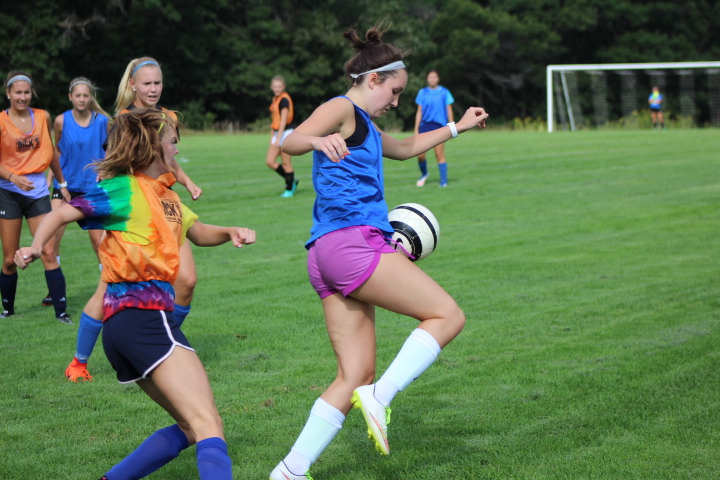(Editor’s note: This was written a month ago but due to space constraints is just now being published.)
by Dave DeMars
news@thenewsleaders.com
It’s mid-August. Two more weeks until the start of the school year. That means it’s the start of the high-school sports season. Coaches are gathering their teams, issuing jerseys, checking physical exam records and getting equipment ready. Athletes are readying themselves as well – getting ready to test their stamina and endurance, as well as their skills..
Girls soccer is among the mix of fall sports and this year Coach Roy Snyder, a Southern California transplant, has the largest number of girls ever. All of them seek to win a coveted spot on the varsity rotation.
“Right now we have 64 registered, ninth through 12th (grades).” Snyder said. We’ll have three levels and we’ll be pretty full this year.”
Snyder is looking forward to a successful season and thinks they will be competitive with some of the better teams in the state.
“We’re bringing back some solid juniors from last year and some young players that played really well,” Snyder said. “We’re excited to see how they really come together. We did lose 11 seniors from last year.”
While the loss of the seniors is like losing an entire team of athletes, Snyder has grown accustomed to the loss. Each year it’s a matter of reloading the the team, getting the charge ready and pulling the trigger come opening day of the season.
“Each year we build from the bottom and see where we end up,” he said. “It’s a really good group.”
Knowing the quality and quantity of the athletes you work with is only part of the coach’s job. It’s knowing what the opposition might have in the line of players and how best to deploy your resources.
Snyder said he expects some stiff competition within the conference.
“I think a lot of teams are going to be a lot better this year,” Snyder said. “ I think Sauk Rapids will be good – and Tech is going to be really good. Apollo won the section last year, and we expect them to be outstanding. Brainerd seems like they win the conference every year, so obviously they’ll be good. And every time we play Alex, it’s 1-0.”
If his expectations hold true, Snyder and his team will have their hands full. Of course, some of those highly rated teams will have lost some of their vaunted seniors as well, so as in every sport, the score at the start of the season is 0-0.
“We are going to start with two of the best teams in the state, Princeton and Blake, so we will get tested right away,” he said.
Blake was a top five school in the state last year, and Snyder said he expects Princeton to be among the top 10. Why play such accomplished schools? The answer is easy. Teams improve most rapidly, particularly in non-conference pre-season, when they play schools that are a step or two above their expected playing capability. It’s a way to measure the grit and determination of your team.
“It would be a nice win for us (if we defeated Blake),” Snyder said. “We’ve played them three or four times in a row now, and we’ve had some close games. We lost 1-0 down there and tied them 0-0 at home a couple years ago. But it’s only one win, and it’s non-conference. We play them because we know they are good and it’s a quality team and it lets us know where we are and where we have to go by the end of the year.”
Asked about any specific standouts, Snyder waxed enthusiastically about his goalkeeper.
“She’s played three years on the second level and really is a fantastic goalkeeper,” said Snyder, referring to Reyna Hager. “I guess she would be the odds-on favorite. But we have a lot of really talented young players, too, and we’ll like to see where they go.”
So what is the key to a really good soccer team? Is it in foot work, the speed, the willingness to sacrifice one’s body or is it being smart about playing the game?
“We are looking for kids (who) will work hard, (who) will come together and support one another,” Snyder said. “The most important thing for us is the character of the kid. We can put them through all the soccer drills, and teach them the tactics – they’re talented athletes. What we are looking for are 18–20 girls who will go out and kill themselves for each other.”
If soccer looks confusing, it’s because you haven’t watched enough of the game. Snyder said he finds beauty and grace in the game and believes if you watch enough of it, you will see the nuance in the game.
One of the tactics of the game is ball possession.
“We try to possess the ball,” Snyder said. “We try to play a lot of combination play. That means we want girls (who) are smart, (who) can see the game and anticipate the game and see it unfolding in front of them They can move the ball to the right spots.”
In the parlance of the coach, they like to push the game. That means there is a kind of controlled aggression.
“You have to be able to run well, and you have to be able to make good runs off the ball,” Snyder said.
“It’s hockey on grass.”

Coach Roy Snyder gives the girls a little pick-me-up pep talk at the first of two weeks of soccer drills and practice. Snyder will have 64 girls, the most ever, playing at three different levels this year.

Eleven seniors make up the core of the Varsity Girls Soccer team including (from left to right) Shea Garlock, Emma Gunderson, Kali Killmer, Reyna Hager, Emma Larson, Molly Voigt, Tianna Mick, Kayla Boehmke, Chloe Yilek, Lizzy Minnerath and Megan Sieben.

Senior Emma Gunderson reveals her most embarrassing moment to underclassmen during an impromptu team-building exercise. Seniors are expected to take leadership roles on the team and keep the team on track in its quest for a successful season.

Senior Tiana Mick receives a high pass and tries to protect the ball from other players on the field. Use of hands is forbidden in soccer, but players can use all parts of the torso and head to try and control the ball and push it in the direction of the goal.

Morgan Kirchner corrals the ball during a scrimmage and prepares to make a passing kick to a teammate.

Emma Janu and Saylor Voss don’t seem to agree over who should have possession of the ball. There’s a lot of contact in soccer, but few collisions.




